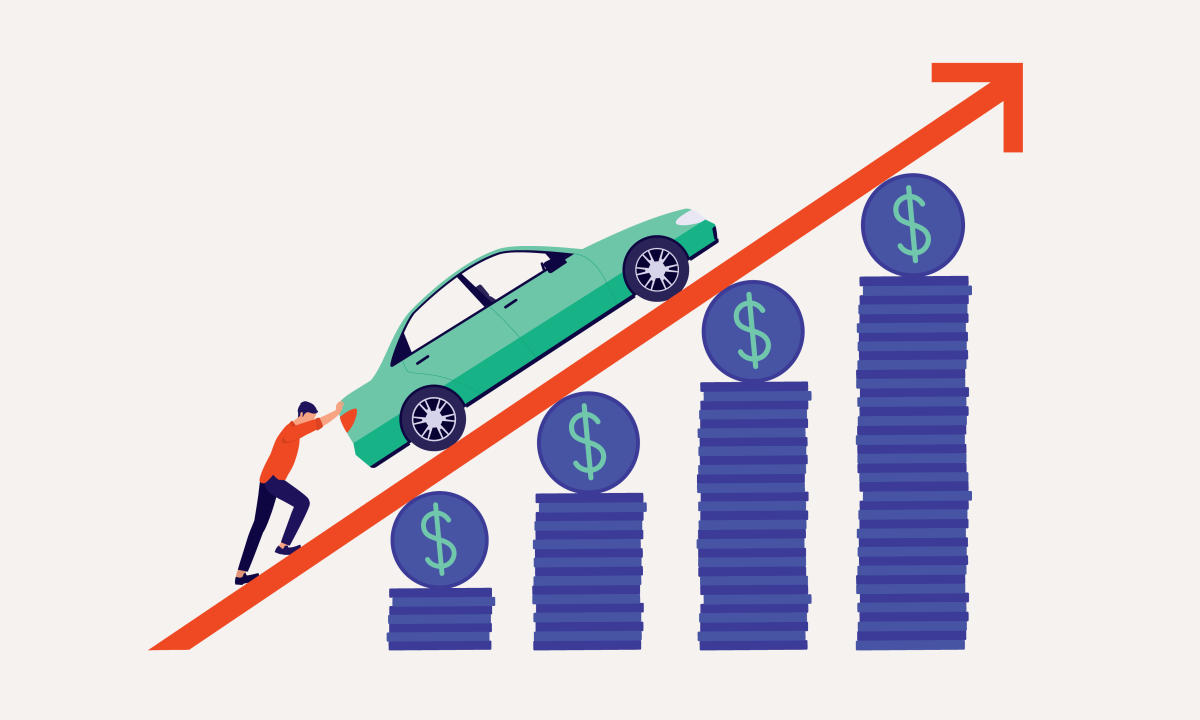Insurance premiums are something we all expect to pay, but when they suddenly rise, it can leave many of us feeling puzzled. Insurance going up isn’t an uncommon issue, but understanding why it happens can help alleviate some of the frustration. Whether it’s your auto insurance, homeowners insurance, or health insurance, premiums can increase for a variety of reasons—some of which are within your control, while others aren’t.
In this guide, we will explore the factors that contribute to rising insurance premiums, explain how different types of insurance policies are affected, and discuss what you can do if you find yourself paying more than you expected.
Table of Contents
ToggleThe Most Common Reasons Why Insurance Rates Go Up
General Economic Factors Affecting Insurance Rates
One of the primary reasons for insurance rates going up is tied to broader economic trends. Insurers, like any business, are affected by market forces, inflation, and changing costs in the industries they serve. Here’s a breakdown of key economic factors that influence premium increases:
- Inflation: Just as the cost of groceries or gas rises, so do the costs that insurance companies must cover. As inflation drives up prices, the cost to replace or repair a vehicle, rebuild a home, or cover medical expenses also rises. To cover these higher payouts, insurers must adjust their rates accordingly.
- Increasing Claim Costs: Whether it’s due to higher medical bills, more expensive vehicle parts, or the growing cost of rebuilding homes, the amount insurers pay out in claims has been steadily rising. For example, if you get into a car accident, it now costs more to repair a car than it did a decade ago due to technological advancements in vehicles.
- Economic Recession or Instability: Economic downturns or financial market instability can also result in insurance premiums going up. During recessions, many businesses see their profits shrink, and insurers are no exception. When investments and financial portfolios that insurers rely on for growth underperform, they sometimes pass on these losses to policyholders in the form of higher premiums.
Industry-Specific Factors Contributing to Insurance Price Increases
It’s important to note that each type of insurance—whether it’s auto, homeowners, or health insurance—has its own specific set of factors that drive premium increases. Below, we’ll dive deeper into the reasons for rising rates within different types of insurance:
- Auto Insurance:
- Advanced Technology in Cars: Modern vehicles are equipped with sophisticated technology—like sensors, cameras, and autonomous driving features. While these technologies make cars safer, they also make them more expensive to repair, leading to higher claim costs for insurers.
- Increased Accident Rates: Distracted driving and traffic congestion contribute to more frequent accidents, resulting in more claims. This increase in claims means insurers have to collect more in premiums to cover the higher volume of payouts.
- Homeowners Insurance:
- Natural Disasters: The frequency and severity of natural disasters like hurricanes, wildfires, and floods are on the rise. As more homes are damaged, insurance companies face increasing numbers of claims, pushing premiums higher, especially in areas prone to these events.
- Rising Construction Costs: Whether due to inflation or labor shortages, the cost to rebuild homes has gone up significantly. For example, lumber prices spiked by 112% from 2020 to 2021, raising the cost of home repairs and rebuilds, which in turn increases homeowners’ premiums.
- Health Insurance:
- Medical Cost Inflation: Health insurance premiums rise largely because of the escalating costs of medical care. Hospitals, pharmaceuticals, and medical devices are becoming more expensive each year. According to a 2023 report, U.S. healthcare costs have risen by an average of 6% annually over the past five years.
- Advances in Medical Technology: While medical technology can save lives, the latest treatments and procedures often come at a higher cost. These expenses lead to increased health insurance premiums as insurers must cover cutting-edge but costly treatments.
Your Personal Factors That May Cause Premiums to Increase
While economic and industry trends play a large role in insurance premiums going up, there are also personal factors that can affect how much you pay:
- Claims History: If you’ve made multiple claims on your insurance in the past, insurers may view you as a higher risk, leading to increased premiums. This applies across most types of insurance, including auto, home, and health policies.
- Credit Score: In many states, insurers use your credit score to assess risk. If your credit score has dropped, insurers may increase your premiums because lower credit scores are often linked to higher claim rates.
- Driving Record: For auto insurance, a poor driving record with accidents or violations can significantly increase your premium. Even minor infractions like speeding tickets can lead to rate hikes.
- Home Value and Improvements: If you’ve made significant improvements to your home—such as adding a new room, upgrading to luxury finishes, or installing a pool—your homeowners insurance may increase to reflect the higher value of your property.
In this section, we’ve explored several reasons why insurance premiums go up. From inflation to personal factors like claims history and credit score, a variety of issues can cause your insurance costs to rise. In the next section, we’ll discuss how state-specific factors—such as natural disasters and regulatory changes—can further influence premium hikes.
State-Specific Insurance Rate Increases
Regional Disasters and Their Impact on Insurance Costs
In many cases, your location plays a significant role in determining how much your insurance premiums will increase. If you live in a region prone to natural disasters, you’re likely to see insurance going up more frequently and sharply than in other areas. Here’s why:
- Increased Frequency of Natural Disasters: The last few decades have seen a significant rise in natural disasters—hurricanes, wildfires, floods, and earthquakes. For example, states like California are facing unprecedented wildfires, while the Gulf Coast is seeing more hurricanes than ever before. These events lead to a spike in claims, which forces insurers to adjust their rates to cover potential future disasters.
- Disaster-Prone Areas: States like Florida, Texas, and Louisiana, which are often hit by hurricanes, experience higher homeowners and flood insurance premiums due to the increased risk. Similarly, California homeowners in wildfire-prone regions often see their insurance costs skyrocket, as the damage from these disasters can be catastrophic and costly for insurers.
Case Study: In 2022, the devastation caused by Hurricane Ian in Florida resulted in insurance companies paying out over $50 billion in claims. In the following year, many Floridians saw their homeowners insurance premiums increase by as much as 30%.
Regulatory Changes in Insurance
State regulations and laws can also impact how much you pay for insurance. Each state has its own insurance regulatory body that sets guidelines for how insurance companies operate within their jurisdiction. These regulations can either keep premiums lower or lead to increases. Key regulatory factors include:
- Changes in State Laws: Some states impose new regulations that require insurers to offer additional coverages or benefits, which can drive up costs. For instance, stricter safety standards or mandatory flood insurance in high-risk areas can lead to higher premiums.
- Rate Approval Process: In many states, insurers must get approval from state insurance departments before they can increase rates. While this can prevent sudden, sharp hikes, it can also delay necessary adjustments, resulting in larger increases later on.
- State-Sponsored Insurance Programs: Some states, like California and Florida, have state-run insurance programs for residents who can’t get affordable coverage in the private market. These programs are often more expensive for participants, but they ensure that even those in high-risk areas can get coverage.
Auto Insurance Rates: Why Are They Going Up?
The Impact of Distracted Driving and Traffic Violations
One of the biggest drivers of auto insurance going up is the rising number of accidents caused by distracted driving. With smartphones becoming more integrated into our daily lives, many drivers are using their devices while on the road, increasing the likelihood of accidents. In fact, the National Highway Traffic Safety Administration (NHTSA) reported that distracted driving was a factor in nearly 3,000 deaths in 2022.
More accidents mean more claims, and more claims lead to higher premiums. Additionally, if you personally have been involved in an accident or have received traffic violations, your insurance rate is likely to go up. Common violations that cause increases include:
- Speeding tickets
- Reckless driving
- DUI convictions
The Rising Costs of Car Repairs and Medical Bills
Cars today are much more complex than they were a decade ago. The inclusion of advanced driver-assistance systems (ADAS), backup cameras, and high-tech sensors makes vehicles safer, but it also makes them more expensive to repair. A simple fender-bender that would have cost a few hundred dollars to fix in the past can now result in thousands of dollars in repair bills.
Similarly, medical costs associated with car accidents are rising. As healthcare costs continue to increase, insurers are paying out more in claims, which they compensate for by raising premiums.
Example: In 2023, the average cost of a car repair after an accident increased by 11% due to the rising complexity of vehicle technology, contributing to the overall rise in auto insurance premiums.
Homeowners Insurance: What’s Behind the Rising Costs?
Natural Disasters and Catastrophes
Homeowners in certain regions have seen their homeowners insurance going up due to the increased frequency of natural disasters. As we mentioned earlier, wildfires, hurricanes, and floods are becoming more common, and this has a direct impact on homeowners insurance premiums.
Flood Insurance Example: After Hurricane Katrina in 2005, the demand for flood insurance in Louisiana skyrocketed. Insurers had to raise premiums significantly to account for the surge in claims and to prepare for future disasters.
Home Improvements and Market Value
Another factor that can cause homeowners insurance premiums to rise is the value of your home itself. If the real estate market in your area is booming, or if you’ve made significant upgrades to your home, your policy may need to be adjusted to reflect the increased value.
For instance, adding a swimming pool, upgrading to a high-end kitchen, or building a new deck can increase the replacement value of your home. While these improvements may enhance your living space, they also mean higher insurance costs.
Pro Tip: When making home improvements, it’s important to notify your insurance provider so they can adjust your coverage. Failing to do so may leave you underinsured if something happens to your home.
Health Insurance: What’s Driving Premiums Up?
Rising Healthcare Costs
The rising cost of healthcare in the United States is one of the main reasons health insurance premiums are going up. Hospitals, pharmaceutical companies, and medical device manufacturers are all charging more, which in turn increases the amount that health insurers need to pay out in claims.
Statistics: According to the Kaiser Family Foundation, the average annual premium for family health coverage reached $22,221 in 2023, up 6.5% from the previous year.
Aging Population and Chronic Conditions
As the population ages, there is a growing need for medical care related to chronic conditions like heart disease, diabetes, and arthritis. The rising prevalence of these conditions means that health insurance companies must pay for more treatments, medications, and hospitalizations, resulting in higher premiums.
What You Can Do When Your Insurance Rates Go Up
Shop Around for Better Rates
One of the most effective ways to counter rising insurance premiums is to shop around for better rates. Many people stick with the same insurance company for years, but other insurers may offer better rates, especially if your personal circumstances have changed (e.g., you’ve improved your credit score or driving record).
Tip: Use comparison websites or work with an insurance broker to get multiple quotes and find the best deal.
Consider Raising Your Deductible
Another strategy to lower your premium is to raise your deductible—the amount you pay out of pocket before your insurance kicks in. While this will reduce your monthly premium, it’s important to weigh the pros and cons:
- Pros: Lower premium, more savings month to month.
- Cons: Higher out-of-pocket costs in the event of a claim.
Take Advantage of Discounts
Many insurers offer a range of discounts that can help offset premium increases. Common discounts include:
- Bundling: If you have multiple policies (e.g., home and auto) with the same provider, bundling them can lead to significant savings.
- Loyalty Discounts: Some insurers reward long-term customers with reduced rates.
- Safety Discounts: For auto insurance, installing anti-theft devices or taking a defensive driving course can earn you a discount.
Improve Your Personal Risk Profile
Improving factors like your credit score or driving record can also help reduce your premiums. A clean driving record free of accidents and violations can lower your auto insurance rate, while a higher credit score can reduce both auto and home insurance premiums.
Frequently Asked Questions (FAQs)
Why did my insurance go up without any claims?
Insurance rates can go up for many reasons unrelated to personal claims. For example, industry-wide factors like inflation or rising repair costs can lead to increases. Your rates may also rise if the overall risk in your area (e.g., natural disasters) has increased.
How can I lower my insurance premiums?
To lower your premiums, consider shopping around for better rates, raising your deductible, and taking advantage of any available discounts. Additionally, improving your credit score and maintaining a clean driving record can help.
Can I negotiate my insurance rate with my provider?
Yes, in some cases, you can negotiate your rate with your insurance provider. Call your agent to discuss your policy and ask about available discounts or opportunities to adjust your coverage for a lower rate.
What happens if I can’t afford my rising insurance premiums?
If you’re struggling to afford your insurance premiums, you may need to adjust your coverage, raise your deductible, or explore options with a different provider. In some cases, you may qualify for state-sponsored insurance programs or subsidies.
Conclusion
Insurance premiums can increase for a variety of reasons, from personal factors like your claims history to industry-wide issues such as inflation or the rising cost of repairs and medical care. Understanding why insurance goes up can help you make more informed decisions about your coverage. By shopping around, improving your risk profile, and taking advantage of discounts, you can help manage rising costs and ensure that you’re getting the best possible rate for your policy.



